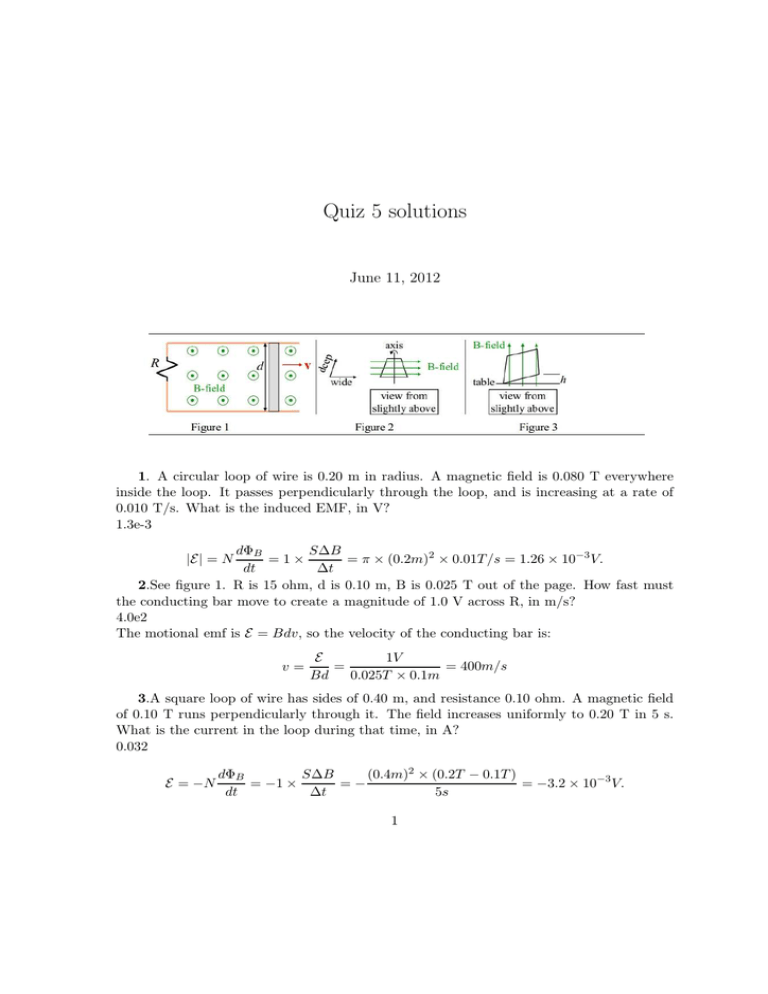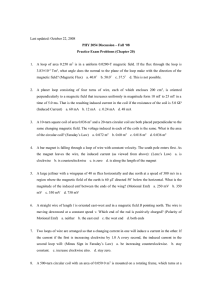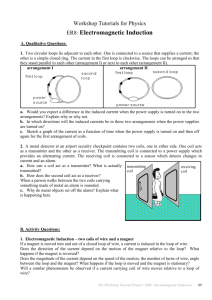Quiz 5 solutions June 11, 2012
advertisement

Quiz 5 solutions June 11, 2012 1. A circular loop of wire is 0.20 m in radius. A magnetic field is 0.080 T everywhere inside the loop. It passes perpendicularly through the loop, and is increasing at a rate of 0.010 T/s. What is the induced EMF, in V? 1.3e-3 dΦB S∆B =1× = π × (0.2m)2 × 0.01T /s = 1.26 × 10−3 V. dt ∆t 2.See figure 1. R is 15 ohm, d is 0.10 m, B is 0.025 T out of the page. How fast must the conducting bar move to create a magnitude of 1.0 V across R, in m/s? 4.0e2 The motional emf is E = Bdv, so the velocity of the conducting bar is: |E| = N v= 1V E = = 400m/s Bd 0.025T × 0.1m 3.A square loop of wire has sides of 0.40 m, and resistance 0.10 ohm. A magnetic field of 0.10 T runs perpendicularly through it. The field increases uniformly to 0.20 T in 5 s. What is the current in the loop during that time, in A? 0.032 E = −N dΦB S∆B (0.4m)2 × (0.2T − 0.1T ) = −1 × =− = −3.2 × 10−3 V. dt ∆t 5s 1 So the magnitude of the induced current is: I= |E| 3.2 × 10−3 V = = 3.2 × 10−2 A. R 0.1Ω 4. A loop of wire lies flat on the ground. Directly above, a bar magnet has its south end down, and north end up. The magnet is dropped toward the loop. During the fall, what describes any induced current in the wire? it is clockwise During the fall, the magnetic field that passes through the loop is pointing up and the magnitude is increasing. According to Lenz’s law, the magnetic field of the induced current would oppose this change. So the induced magnetic field would point down, which means the induced current would be clockwise. 5. See figure 3. A square loop of wire is 0.50 m on a side. One edge lies on a table, while the opposite edge is raised h = 0.30 m above the table. A magnetic field of 3.0 T is perpendicular to the table. What is the magnitude of the flux through the loop, in T − m2 ? 0.60 Because the magnetic field is uniform and the loop is lying in a plane, the magnetic flux is: Z Z ~ · dA ~ = BdAcosθ = BAcosθ, ΦB = B ~ is perpendicular with the where B = 3.0T , A = (0.5m)2 = 0.25m2 . The direction of A ~ ~ plane of the √ loop, so the√angle between A and B is θ = arcsin(0.3m/0.5m) = arcsin(0.6), so cosθ = 1 − sin2 θ = 1 − 0.62 = 0.8. So we have: ΦB = BAcosθ = 3T × 0.25m2 × 0.8 = 0.6T m2 . 6.See figure 2. The rectangular loop is 0.30 m deep by 0.10 m wide, and rotates at 5.0 rad/s. B is 0.010 T. What is the peak voltage induced in the loop, in V? 0.0015 The maximum emf is obtained when the loop is parallel with the B-field. At that time the motional emf generated by one side that is perpendicular to the B-field is:E = Blv = 0.01T × 0.3m × 5/s × (0.1m/2) = 7.5 × 10−4 V , where we use v = ωr and r is half of the width. Because there are two sides that generate the same emf, so the total peak voltage is:7.5 × 10−4 V × 2 = 1.5 × 10−3 V. 7.A coil of wire floats in space directly above a second coil of wire. When viewed from above, the current in the first coil is counter-clockwise, and the current in the second coil is clockwise. Gravity pulls downward, as usual. The force between the coils is ... 2 repulsive The first coil feels the magnetic field generated by the second coil(See picture above), and ~ = Id~l × B. ~ Although the direction of the the force on each element of the first coil isdF forces on each element are different, they all have a positive z component, so the total force on first coil is pointing up. You can do the same analysis to the second coil, or you can just use Newton’s 3rd law and conclude that the force on the second coil is pointing down. So the forces between the coils is repulsive. 8. See figure 1. R is 20. ohms. The induced voltage is 2.0 V. How much power is needed to pull the bar, in W? 0.20 2 2 2 ~ = IdBv = Bdv dBv = (Bdv) = E = (2V ) = 0.2W P = F v = |I~l × B|v R R R 20Ω Actually the power to pull the bar is equal to the power of the resistor. 9.A capacitor with a dielectric is charged, and disconnected from the circuit. It stores energy. I then remove the dielectric between the plates. What happens to the stored energy? it increases 3 Because C = κC0 and κ > 1. This dielectric increases the capacitance of the capacitor. 2 According to electric potential energy U = Q 2C , C decreases while Q is the same(because the capacitor is disconnected from the current), so U increases. 10.A loop of wire has 20.0 turns, and is made of wire with radius 0.50 mm. The flux through it is 0.10 T − m2 . The flux drops uniformly to zero in 2.0 s. What is the induced EMF during that time, in V? 1.0 |E| = N | 0.1T m2 dΦB | = 20 × = 1V dt 2s 4






